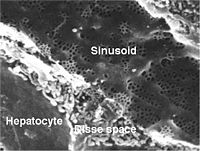
Photo from wikipedia
Homeostatic adaptation to systemic iron overload involves transcriptional induction of bone morphogenetic protein 6 (BMP6) in liver sinusoidal endothelial cells (LSECs). BMP6 is then secreted to activate signaling to the… Click to show full abstract
Homeostatic adaptation to systemic iron overload involves transcriptional induction of bone morphogenetic protein 6 (BMP6) in liver sinusoidal endothelial cells (LSECs). BMP6 is then secreted to activate signaling to the iron hormone hepcidin (HAMP) in neighboring hepatocytes. To explore the mechanism for iron sensing by LSECs, we generated TfrcTek-Cre mice with endothelial cell-specific ablation of transferrin receptor 1 (Tfr1). We also used control Tfrcfl/fl mice to characterize LSEC-specific molecular responses to iron by single-cell transcriptomics. TfrcTek-Cre animals tend to have modestly increased liver iron content (LIC) compared to Tfrcfl/fl controls but express physiological Bmp6 and Hamp mRNA. Despite a transient inability to upregulate Bmp6, they eventually respond to iron challenges with Bmp6 and Hamp induction, yet occasionally to levels slightly lower relative to LIC. High dietary iron intake triggered accumulation of serum non-transferrin bound iron (NTBI), which significantly correlated with liver Bmp6 and Hamp mRNA levels and elicited more profound alterations in the LSEC transcriptome compared to holo-transferrin injection. These culminated in robust induction of Bmp6 and other nuclear factor erythroid 2-related factor 2 (Nrf2) target genes, as well as Myc target genes involved in ribosomal biogenesis and protein synthesis. LSECs and midzonal hepatocytes were the most responsive liver cells to iron challenges and exhibited highest expression of Bmp6 and Hamp mRNAs, respectively. Our data suggest that during systemic iron overload, LSECs internalize NTBI, which promotes oxidative stress and thereby transcriptionally induces Bmp6 via Nrf2. Tfr1 appears to contribute to iron sensing by LSECs mostly under low iron conditions.
Journal Title: Blood
Year Published: 2022
Link to full text (if available)
Share on Social Media: Sign Up to like & get
recommendations!